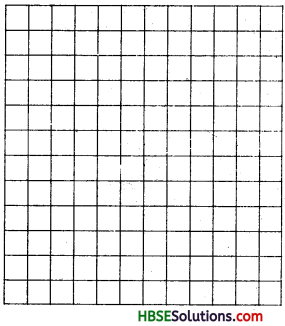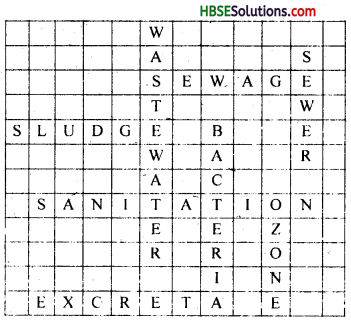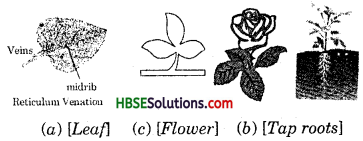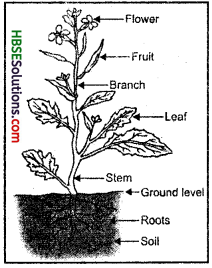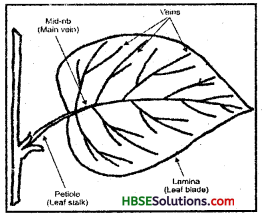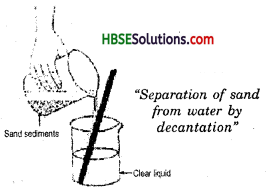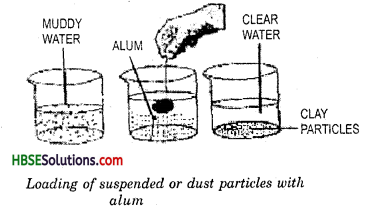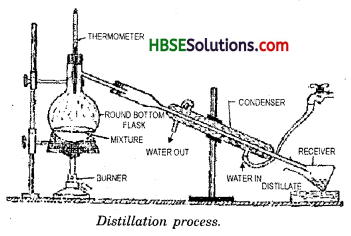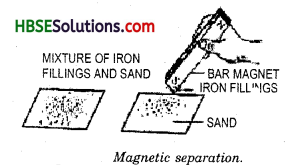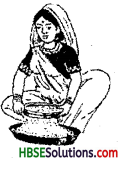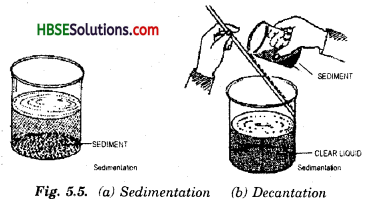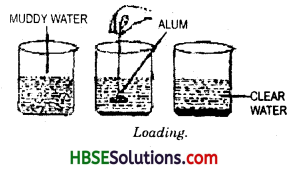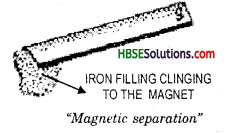HBSE 7th Class Science Solutions Chapter 16 Water: A Precious Resource
Haryana State Board HBSE 7th Class Science Solutions Chapter 16 Water: A Precious Resource Textbook Exercise Questions and Answers.
Haryana Board 7th Class Science Solutions Chapter 16 Water: A Precious Resource
HBSE 7th Class Science Water: A Precious Resource Textbook Questions and Answers
Question 1.
Mark ‘T” if the statement is true and ‘F’ if it is false:
(a) The freshwater stored in the ground is much more than that present in the rivers and lakes of the world. (T/F)
(b) Water shortage is a problem faced only by people living in rural areas. (T/F)
(c) Water from rivers is the only source for irrigation in the fields. (T/F)
(d) Rain is the ultimate source of water. (T/F)
Answer:
(a) T, (b) F, (c) F, (d) T.
Question 2.
Explain How gropndwater is recharged?
Answer:
The ground water get recharged through the process of infiltration. Infiltration means seeping in water from rivers and lakes into the empty spaces and crack deep below the ground.
Question 3.
There are ten tubewells in a lane of fifty houses. What could be the long term impact on the water table?
Answer:
The effect on the water table depends on the replenishment of the underground water. As only five families will share a tubewell, the water used for daily domestic purpose will not effect the water table as such. But if there is acute shortage of rains the water used by the families will not replenished and water table will fall down.
Question 4.
You have been asked to maintain a garden. How will you minimise the use of water?
Answer:
The water is used to water the plants in a garden. To minimise the wastage of water we will use the technique of drip irrigation, which directly throws water at the base of plants. I will Check the leakages in the water papers. I will arrange small pits for rain water harvesting, The collected rain water will be used for watering loiter.
![]()
Question 5.
Explain the factors responsible for the depletion of water table.
Answer:
Various factors are responsible for the depletion of water table
(i) Increased Population : Increase in the human population has increased the demand for water. As the number of humans will keep on increasing, the consumption of water will also increase. Sources of water remain limited but consumption keeps on increasing causing great fall in, water table.
(ii) Increasing industries : All industries need water. Inlith increase in human population, the number of industries has also increased; so has increased the consumption of water mainly from ground. This has caused depletion of ground water.
(iii) Agricultural activities : India is a country whose economy depends on the agriculture. With time the land used for cultivation has increased. Therefore, the consumption of water for agricultural purpose has increased. Rains are the main source of water for irrigation. But irregular rain fall has increased the dependence of farmers on the ground water. This has increased the depletion of ground water.
(iv) Lack of water conservation techniques : Main source of/water on earth and for the underground water is the rain. The water of the rain, if conserved can increase the water level. But this is not done due to the lack of rain water harvesting techniques and other water conservation techniques.
Question 6.
Fill in the blanks with the appropriate answers :
(a) People obtain groundwater through _______ and _______ .
(b) Three forms of water are _______, _______ and _______ .
(c) The water bearing layer of the earth is _______.
(d) The process of water seewage into the ground is called _______.
Answer:
(a) wells and handpumps
(b) solid, liquid and vapour
(c) aquifer
(d) infiltration
Question 7.
Which one of the following is not responsible for water shortage?
(i) Rapid growth of industries.
(ii) Increasing population.
(iii) Heavy rainfall.
(iv) Mismanagement of water resources.
Answer:
(iii) Heavy rainfall.
Question 8.
Choose the correct option. The total water
(i) in the lakes and rivers of the world remains constant.
(ii) under the ground remains constant.
(iii) in the seas and oceans of the world remains constant.
(iv) of the world remain constant.
Answer:
(iii) in the seas and oceans of the world remains constant.
![]()
Question 9.
Make a sketch showing groundwater and water tube. Label it.
Answer:
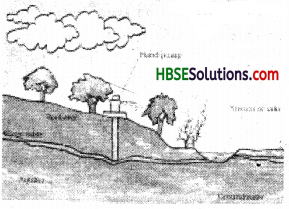
Question 10.
Explain how ground water is recharged.
Answer:
The ground water get recharged through the process of infiltration. Infiltration means seeping in water from rivers and lakes into the empty spaces and crack deep below the ground.
Extended Learning-Activities and Projects
Question 1.
Role play
You are a water detective in your school. You have a team of six members. Survey the campus and make a note of the following:
(a) Total number of taps
(b) Number of taps leaking
(c) Amount of water wasted due to leakage
(d) Reasons of leakage
(e) Corrective measures taken
Answer:
Do it yourself.
Question 2.
Groundwater pumped out
Try to find out if there are any hand pumps in your neighbourhood. Go to the owner or the users of a few of these and find out the depth at which they struck water? If there are any differences, think of the probable reason. Write a brief report and discuss it in your class. If possible, visit a place where boring is going on to install a hand pump. Watch the process and find out the depth of the water table at that place. .
Answer:
Do it yourself.
Question 3.
Catching rainwater – Traditional methods
Form groups of 4 to 5 students in the class and prepare a report on the various traditional ways of water harvesting.
Answer:
Do it yourself.
![]()
Question 4.
Conservation of water
Carry out a compaign to conserve water at home and in the school. Design posters to remind others of the importance of water resources.
Answer:
Do it yourself.
Question 5.
Create a logo
Hold a competition to create a logo or a symbol depicting water scarcity.
Answer:
Do it yourself.
HBSE 7th Class Science Water: A Precious Resource Important Questions and Answers
Very Short Answer Type Questions
Question 1.
When do we celebrate water day?
Answer:
We celebrate water day on 22nd March every year.
Question 2.
How much minimum water is required by an individual for his daily requirements?
Answer:
According to survey of United Nations every individual require 50 litres of water every day.
Question 3.
What is the main source of water on the earth?
Answer:
Rain is the main source of water on the earth.
Question 4.
Name the main sources of the natural water.
Answer:
Main source of natural water on earth are two : Surface water and underground water.
Question 5.
What are the sources of surface water?
Answer:
Rain water, River and lake water and sea water are the three sources of surface water on earth.
![]()
Question 6.
What do you mean by underground water?
Answer:
Water from rain and other sources of surface water seeps inside the earth to fill the empty spaces and crack. It is called underground water.
Question 7.
What do you mean by infiltration?
Answer:
The process of seeping of water into the empty spaces of the ground is called infiltration.
Question 8.
What do you understand by aquifer?
Answer:
Aquifer is the underground water bearing layer of the earth, which is below the water table.
Question 9.
What are main sources of underground water?
Answer:
Main sources of underground water are springs, tubewells, wells, handpumps etc.
![]()
Question 10.
What is depletion of water table?
Answer:
Falling level of water at the water table is called depletion of water table.
Question 11.
Name the factors affecting the depletion of water table.
Answer:
Increase in human population, increasing industries and increasing agricultural activities are cause of depletion of water table.
Question 12.
What is water management?
Answer:
Minimum wastage of water is called water management.
Question 13.
What is drip irrigation?
Answer:
It is a technique using narrow tubings to water plants directly at their base without wasting water.
Question 14.
What symplasm in plants show scarcity of water?
Answer:
Wilting and drying.
Question 15.
How can we utilize the rain water?
Answer:
We can store rainwater with help of rain water harvesting techniques.
Short Answer Type Questions
Question 1.
What is the role of water in sustaining life on earth?
Answer:
Water is very important in sustaining life on earth. All the metabolic functions of living beings cannot be ‘performed without water. It provides habital to several animals and plants. So no living organism can survive without water.
Question 2.
What is surface water? What are its source?
Answer:
The water present on the surface of the earth is called the surface water. It can be obtained from rain water, water from rivers and lakes sea water contains maximum surface water.
Question 3.
What is underground water and how can it be obtained?
Answer:
A part of rain water gets percolated into the ground and collect to form a water table. This water is called underground water. Underground water can be obtained from springs, wells and tubewells. Handpumps are also means of obtaining underground water.
Question 4.
What is conservation of water? How can we conserve water.
Answer:
Conservation of water is the wise and fundicious use if, water by us. We can conserve water of harvesting rain water, minimising the wastage of water in houses and industries, using conservation techniques like drip irrigation in agriculture etc. can conserve our fresh water resources.
![]()
Question 5.
What do you mean by rainwater harvesting?
Answer:
Collecting and conserving the rain water from the roof tops of the buildings is called rain water harvesting. Water from the roof tops of the houses, industries etc. is collected. It is used directly or allowed to seep into the soil instead of allowing it to flow down. It helps in raising the water table.
Question 6.
What are water-wise habits?
Answer:
Following are the water-wise habits:
- brushing teeth shaving, etc with taps turned off while not using water.
- moking floor instead of washing.
- using small cisterns in toilets.
- using a bucket and mug to take bath instead of bathing under a shower.
- using harvested rain water.
Long Answer Type Questions
Question 1.
List main sources of water explaining each one briefly.
Answer:
There are mainly two sources of natural water.
(i) Surface water : The water which is present on the surface of earth is called the surface water.
It is of three types :
- Rain water : Rain water is the main source of water on the earth. It is the purest form of natural water.
- River and Lake water : The water is rivers and lakes came from rain and melting of snow.
- Sea water : Water from rivers, lakes and streams flow into the sea. Sea water cannot be consumed because it contains various soluble salts.
(ii) Underground Water : A part of rain water predates into the soil and gets collected there. It is called underground water. It can be obtained from the following :
- Spring Water : Some times the water that is collected above the rocks exert pressure. Consequently it comes out from any opening in the earth. It is called spring water.
- Well Water : Water collected inside the earth is called water table. Wells are dug to obtain water, borings are made to instal a hand pump or a tube well.
Question 2.
List the cause and effects of water scarcity.
Answer:
Cause of water scarcity : Following reasons cause the scarcity of fresh water on earth :
(а) Uneven Distribution of water :
There is uneven rainfall on the earth. Some places receive planty of rainfall while others do not receive any rain. Almost about half of the earths land area does not get sufficient rain.
(b) Lack of conservation facilities : Most of the rain water goes waste as it cannot be absorbed in the earth. It runs into other resources like sea, rivers etc. This water otherwise can be percolated into the soil and raise water table. Constructing small reservoirs, artificial lakes and other storage facilities can increase the water table.
(c) Pollution of water : Considerable amount of consignable water gets polluted due to human and industrial activities. This water if not polluted, can be consumed by human beings.
Effects following are the effects of water scarcity :
- acute shortage of water.
- drying up of pumps and lakes.
- failure of crops thus shortage of food.
- death of man and cattle.
Water: A Precious Resource Class 7 HBSE Notes
- Water is a vital natural resource.
- Main sources of natural water are surface water and underground water.
- Rain is the main source of water on the earth.
- Rainwater river and lake water and seawater are the sources of surface water.
- Springwater tubewells hand pumps are the means of obtaining under groundwater.
- level of water under the ground is called water table.
- Infiltration is the seeping of rainwater into the soil.
- Infiltration increases the water table.
- Excess usage of groundwater depletes the water table.
- Rainwater harvesting, drip irrigation etc. helps in conserving water.
- Increase in population, increase in industries, etc. Cause scarcity of water.
- Security of water can snatch away the greenry from the earth.
HBSE 7th Class Science Solutions Chapter 16 Water: A Precious Resource Read More »

